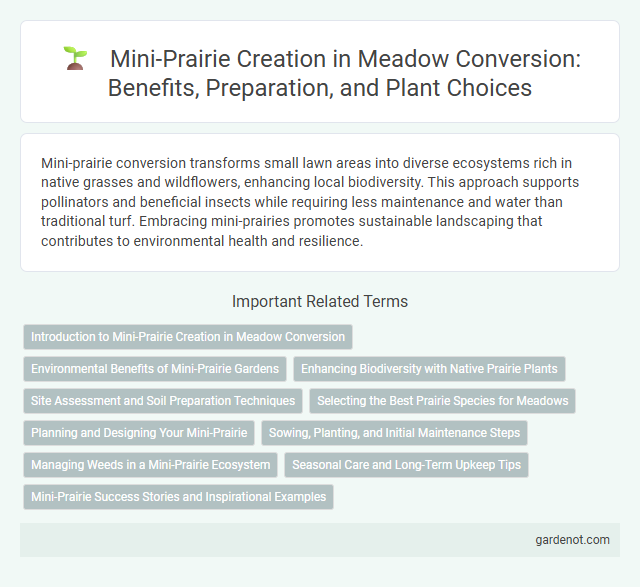Mini-prairie conversion transforms small lawn areas into diverse ecosystems rich in native grasses and wildflowers, enhancing local biodiversity. This approach supports pollinators and beneficial insects while requiring less maintenance and water than traditional turf. Embracing mini-prairies promotes sustainable landscaping that contributes to environmental health and resilience.
Introduction to Mini-Prairie Creation in Meadow Conversion
Mini-prairie creation in meadow conversion involves planting diverse native grass species like little bluestem and switchgrass to establish a resilient ecosystem. This method enhances soil health by increasing organic matter and supporting beneficial microorganisms, promoting sustainable land use. Implementing mini-prairies improves biodiversity by providing habitat for pollinators and wildlife, contributing to ecological balance.
Environmental Benefits of Mini-Prairie Gardens
Mini-prairie gardens enhance biodiversity by providing native habitats for pollinators, birds, and beneficial insects, contributing to ecosystem stability. These gardens improve soil health through deep-rooted native plants that increase organic matter, promote water infiltration, and reduce erosion. Integrating mini-prairie landscapes supports carbon sequestration, helping mitigate climate change by capturing atmospheric CO2 efficiently.
Enhancing Biodiversity with Native Prairie Plants
Mini-prairies enhance biodiversity by incorporating a diverse mix of native prairie plants adapted to local conditions. These native species support pollinators, birds, and beneficial insects, creating a balanced ecosystem. Integrating deep-rooted grasses and wildflowers improves soil health and water retention, fostering sustainable habitat development.
Site Assessment and Soil Preparation Techniques
Site assessment for mini-prairie conversion involves analyzing soil pH, texture, drainage, and existing vegetation to ensure optimal conditions for native prairie species. Soil preparation techniques include mowing or grazing to reduce competition, followed by minimal tillage to preserve soil structure and enhance seed-to-soil contact. Incorporating organic matter and adjusting nutrient levels based on soil test results support robust plant establishment and long-term prairie health.
Selecting the Best Prairie Species for Meadows
Selecting the best prairie species for mini-prairie conversions involves choosing native grasses and wildflowers that are well-adapted to local climate and soil conditions. Species such as little bluestem, switchgrass, and purple coneflower provide ecological benefits, support pollinators, and enhance biodiversity. Incorporating a diverse mix of warm-season grasses and perennial forbs ensures resilience and seasonal interest throughout the growing season.
Planning and Designing Your Mini-Prairie
Careful planning and designing your mini-prairie involves selecting native grasses and wildflowers that thrive in local soil and climate conditions, ensuring biodiversity and ecological balance. Incorporate layered plant structures to support pollinators and wildlife while creating visual interest throughout seasons. Proper site preparation, including soil testing and weed management, maximizes establishment success and long-term sustainability of the mini-prairie.
Sowing, Planting, and Initial Maintenance Steps
Mini-prairie sowing requires selecting native wildflower and grass seeds adapted to local soil and climate conditions to ensure robust growth. Planting involves preparing the soil by removing weeds and loosening the ground to promote seed-to-soil contact, typically in early spring or fall for optimal germination. Initial maintenance includes regular watering, monitoring for invasive species, and minimal mowing to support young plant establishment and encourage biodiversity.
Managing Weeds in a Mini-Prairie Ecosystem
Managing weeds in a mini-prairie ecosystem requires targeted strategies such as regular monitoring and manual removal to prevent invasive species from dominating native plants. Utilizing mulch and selective herbicides can suppress weed growth without harming desirable flora, promoting biodiversity. Maintaining soil health through appropriate mowing and controlled burns encourages the resilience of native prairie species against weed encroachment.
Seasonal Care and Long-Term Upkeep Tips
Mini-prairie landscapes benefit from seasonal care such as spring soil aeration and targeted weeding to promote native grass and wildflower health. Regular mowing in late fall helps manage invasive species while leaving seed heads supports wildlife through winter. Long-term upkeep requires monitoring plant diversity and periodic reseeding to maintain ecological balance and aesthetic appeal.
Mini-Prairie Success Stories and Inspirational Examples
Mini-prairie projects have transformed small urban spaces into thriving ecosystems, showcasing increased native plant diversity and supporting pollinator populations. Successful examples include community gardens in Chicago that turned vacant lots into vibrant habitats attracting bees, butterflies, and bird species. These initiatives demonstrate how compact prairie restorations contribute to urban biodiversity and environmental education.
Mini-prairie Infographic

 gardenot.com
gardenot.com